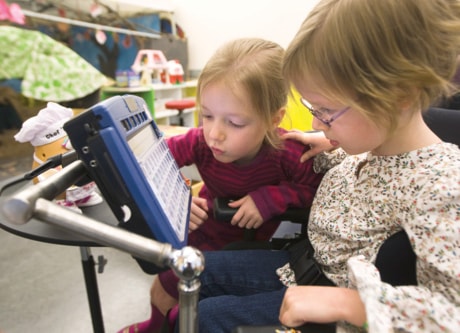TORONTO — Katie and Emily Suggitt take turns picking shoes, eyes, a mouth and nose as they put together their version of Mr. Potato Head, giggling as they watch their creation unfold.
“That looks silly,” says Katie as her five-year-old identical twin adds a moustache, then hangs a purse from the toy’s arm.
But the pronouncement doesn’t come from Katie’s mouth — it emanates from a computerized speech-generating device that has given the little girl a voice.
Katie was born with cerebral palsy, a condition caused by a lack of oxygen to the brain either before or during birth, which has left her with some physical weaknesses and developmental delays — including her ability to speak. (Emily does not have the condition.)
At Bloorview Kids Rehab in Toronto, where the twins both attend senior kindergarten, Katie is being taught to use the speech-generating device that’s been custom-designed for her particular needs and development.
A monitor provides access to multiple screens, each with its own grid of 45 squares containing words paired with illustrative drawings or photos.
Designed to be set on a table or mounted to Katie’s wheelchair, the device allows her to switch from screen to screen and touch a series of word-pictures to activate her “voice.”
The computerized voice, programmed to sound like that of a young child, speaks the words she is physically unable to utter. Over time, the machine will give her access to thousands of words and phrases.
Katie has developed some speech, says her mother, Sarah Nixon-Suggitt. “She can say Mommy and Dada and Em and yes and no very clearly.”
But her inability to articulate the simplest of desires was stressful for both Katie and her family, who were often left guessing what she wanted.
“There was frustration there for Katie,” her mother acknowledges, especially with Emily talking a “mile a minute.”
The speech-generator Katie was fitted with 18 months ago has “opened up a whole new world” for her daughter, Nixon-Suggitt says. And in the last few months — especially since school started — Katie’s ability to communicate through her device has really taken off.
“So she tells us about her school day with that at the dinner table. We all talk about our day, and she asks about our day. She tells me if she wants lemonade versus apple juice or whatever.”
After a recent class outing to a farm, Katie was able to tell her family about the animals she saw and the vegetables she and her classmates picked.
When the family goes out to breakfast on Sunday mornings, Katie can order from the servers herself (the restaurant’s menu and pictures of staff with their names have been programmed into the gadget).
“We encourage her to tell us in the form of a sentence,” says her mother. “So she can say: ’I want a to drink a lemonade.”’
“Sometimes the message involves multiple screens. So the other day she said, ’Daddy’ on one screen, then went to another screen and said, ’I love you.”’
“We’ve always felt as parents that she’s bright and she’s right there with Emily. But you can really see it through this device. And more importantly, other people — teachers and therapists — can see it.”
Laurel Robinson, a Bloorview speech-language pathologist on the team that works with Katie, says the speech-generator is just one form of what’s called augmentative and alternative communication. Other forms include sign language, gestures, eye gazes and pointing to objects or pictures.
“Different systems work for different children and are based on our assessments,” she explains.
“Everything gets customized to the child.”
Robinson says many of the children who need assistance to communicate — because they have limited speech or are completely non-verbal — have cerebral palsy. Others may have language difficulties because they have autism or a brain injury.
Some children whose physical restrictions make them unable to use their fingers to push on the screen can operate a voice-generating device with head switches or a head pointer.
“The children pick up quite quickly and own the system that they have because they realize the value and the importance and, ’Hey, I just did this and you gave me what I want. Isn’t that cool?”’
“This is their voice.”
Katie and a classmate who also uses a speech-generator chatter away to each other, says her mother, and the bond the two have formed has really helped her daughter blossom.
The two girls “tell jokes back and forth at lunchtime,” says Nixon-Suggitt, using a knock-knock joke page on their devices.
“Her favourite one is Dwayne,” she says.
Asked to tell a visitor a joke, Katie gives a mischievous smile and starts pushing on her screen.
“Knock, knock,” she says.
“Who’s there?”
“Dwayne,” she replies.
“Dwayne who?”
“Dwain the bathtub, I’m dwowning!”
Her punchline delivered, Katie grins with satisfaction as everyone around her cracks up.
She throws back her head and laughs with pure joy.
